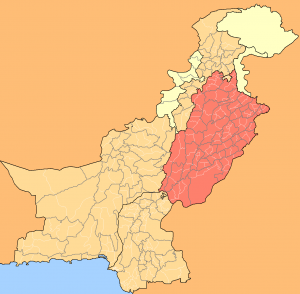Punjab (Pakistan)
The Punjab province of Pakistan is by far the country's most populous and prosperous region and is home to the Punjabis and various other groups. Neighbouring areas are Sindh to the south, Balochistan and the North West Frontier Province to the west, Pakistani-administered Azad Kashmir, Islamabad to the north, and India to the east and north-east.
- The provincial capital is Lahore.
- Nearly 60% of Pakistan's population lives in the Punjab.
The name Punjab literally translates from the Persian words Pañj (پنج) , meaning Five, and Āb (آب) meaning Water. Thus Punjab can be translated as (the) Five Waters - and hence the Land of the Five Rivers, referring to the Jhelum, Chenab, Ravi, Beas and Sutlej these five rivers are all the tributaries of the Indus River. The province was founded in its current form in May 1972.
Geography
Punjab is Pakistan's second largest province at 205,344 km² (79,284 Square miles) after Balochistan and is located at the north-western edge of the geologic Indian plate in South Asia. The provincial level-capital and main city of the Punjab is Lahore which has been the historical capital of the region. Other important cities include Multan, Faisalabad, Sialkot, Gujranwala and Rawalpindi.
It is the nation's only province that touches Balochistan, North-West Frontier Province, Sindh and Azad Kashmir, and contains the federal enclave of the national capital city at Islamabad.
This geographical position and a large multi-ethnic population strongly influence Punjab's outlook on National affairs and induces in Punjab a keen awareness of the problems of the Pakistan's other important provinces and territories. In the acronym P-A-K-I-S-T-A-N, the P is for PUNJAB.
The province is a mainly a fertile region along the river valleys, while sparse deserts can be found near the border with India and Balochistan. The region contains the Thar and Cholistan deserts. The Indus River and its many tributaries traverse the Punjab from north to south.
The landscape is amongst the most heavily irrigated on earth and canals can be found throughout the province. Weather extremes are notable from the hot and barren south to the cool hills of the north. The foothills of the Himalayas are found in the extreme north as well.
Demographics and society
The population of the province is estimated to be 86,084,000 in 2005 and is home to over half the population of Pakistan. The major language spoken in the Punjab is Punjabi (which is written in a Perso-Arabic script in Pakistan) and Punjabis comprise the largest ethnic group.
The population of Punjab (Pakistan) is estimated to be between 85%-95% Muslim with a Sunni majority and Shia minority (The the Pakistani Government doesn't keep track of religious demographics). The largest non-Muslim minority is estimated to be Christians, who are thought to make up 3-5% of the population; other minorities include Hindus, Sikhs, Parsis and Bah'ai.
Sikhs
At the beginning of the fifteenth century, the religion of Sikhism was born, and during the Mughal period gradually emerged as a formidable military force until subjugated and assimilated by the later rising and expanding Sikh Empire. After fighting Ahmad Shah Durrani, the Sikhs wrested control of the Punjab from his descendants and ruled in a confederacy, which later became the Sikh Empire of the Punjab under Maharaja Ranjit Singh. A denizen of the city of Gujranwala, the capital of Ranjit Singh's empire was Lahore. The Sikhs made architectural contributions to the city and the Lahore Fort.
The undivided Punjab, of which Punjab (Pakistan) forms a major region today, was home to a large minority population of Punjabi Sikhs and Hindus unto 1947 apart from the Muslim majority.

